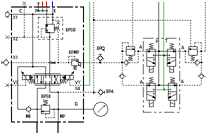| |
| Hydraulic Pump and Motor Design |
The best in the world . . .
I spent many years helping in the design and development of a hydraulic pump and motor design that is still considered to be the most efficient in the world, under the direction of R.J. Ifield, a brilliant and prolific inventor of fuel systems for jet engines, automotive transmissions, hydraulic equipment and others.
Although I had previous experience in design and development in the manufacturing, mining and construction industries, this is where I learnt the nitty gritties of mechanical design - the hard grind of complex mechanisms requiring innovative mathematics, stress analysis, materials selection, bearing combinations, surface treatments, etc, etc - and of development - the long hours of trial and test, the constant checking of instruments and results, the art of knowing what to do when you aren't sure what you are doing.
As with everything else, it is fairly easy to make a hydraulic pump that works, the 90% solution as it were, but the task of pushing the boundaries back to a better, to the best, requires enormous effort and determination.
The schoolroom . . .
We mostly funded the development of the best pump by doing hydraulic repair and service work, mostly in underground coal mining which used a lot of hydraulic equipment at the time. There is no better schoolroom than fixing other peoples problems. The hydraulic systems were not reliable, partly from design limitations in the hydraulic components, partly from system design and partly from user maintenance practice.
|
By the time we had analysed and tested the components, worked out the weak points of the systems and learnt the problems of the user, and then applied that experience across a wide range of industries, we were in definite danger of being experts. We also had a better pump. Many things happen best in partnership and in this case the design and development of the pump gave better insight into the servicing problems and the detailed knowledge of the real world gave a better understanding of the design requirements for hydraulic components and systems. |
 |
|
Hydraulic Systems |
Invisible . . .
Hydraulic systems are unusual in mechanical engineering in that you cannot see what is going on because it is all sealed inside pipes and casings. It is sometimes possible to have a malfunctioning system and take all the components apart and see nothing obviously wrong or broken. Understanding of the system has to be by inference rather than by direct observation.
Quality . . .
Obviously, different applications need different quality/cost levels of hydraulic system and installation. However, there are no simple guidelines to quality in hydraulic systems; there is a rough split between mobile and industrial equipment with mobile equipment being less suitable for higher powers and continuous high pressure operation, but that is all. The need to be cost competitive means that suppliers are forced to propose the lowest quality solution that they consider will be just adequate. To their credit, most of the time they get it right, and provide an acceptable cost/quality balance, but sometimes it does go wrong.
|
The times to be wary, and maybe get some independent assistance, are when the application uses high power or continuous high pressure, has severely fluctuating loads, requires very long life, high reliability or high efficiency, or operates in an arduous environment. From this, it is natural that I mostly get involved in large hydraulic systems (500 kW+), those with special requirements, or those that go wrong. Because I have been involved on many occasions when things did go wrong, I have a sort of armed truce relationship with the suppliers of hydraulic equipment. I am sure that there have been times when they wished I was not there . . . |
 |